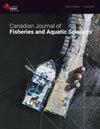Variation in estuary use patterns of juvenile Chinook salmon in the Fraser River, BC
IF 2.2
2区 农林科学
Q2 FISHERIES
Canadian Journal of Fisheries and Aquatic Sciences
Pub Date : 2024-08-20
DOI:10.1139/cjfas-2024-0012
引用次数: 0
Abstract
Canadian Journal of Fisheries and Aquatic Sciences, Ahead of Print.Juvenile Pacific salmon (Oncorhynchus spp.) use estuary habitats to varying degrees with some species and populations thought to rely heavily on these areas for early growth. In the Fraser River, British Columbia, there are 18 distinct conservation units of Chinook salmon (O. tshawytscha), and all but one is of conservation concern. Our study compares the outmigration timing, size, and habitat use of juvenile Chinook salmon in the Fraser River estuary. Over 5 years (2016–2020), we captured 6493 juvenile Chinook salmon, with 3318 sampled for stock identification. Fraser River Chinook salmon extensively used estuary habitats, but patterns varied considerably by population. Juvenile Chinook salmon from the Lower Fraser River were most abundant and present the longest, arriving the smallest in late March and early April, and captured until July. South Thompson ocean-type Chinook salmon entered the estuary later, starting to arrive in late May or early June and remaining present until mid-August. Overall, juvenile Chinook salmon varied considerably in their estuary use across populations. Understanding this variation can inform differences in productivity and guide recovery actions.
不列颠哥伦比亚省弗雷泽河幼年大鳞大麻哈鱼河口利用模式的变化
加拿大渔业与水产科学杂志》(Canadian Journal of Fisheries and Aquatic Sciences),打印前。 太平洋鲑鱼(Oncorhynchus spp.)幼鱼在不同程度上使用河口栖息地,其中一些物种和种群被认为主要依赖这些区域进行早期生长。在不列颠哥伦比亚省弗雷泽河,奇努克鲑(O. tshawytscha)有 18 个不同的保护单元,除一个单元外,其他单元均受到保护。我们的研究比较了弗雷泽河河口大鳞大麻哈鱼幼鱼的外迁时间、大小和栖息地利用情况。在 5 年的时间里(2016-2020 年),我们捕获了 6493 条幼年大鳞大麻哈鱼,其中 3318 个样本用于种群鉴定。菲沙河大鳞大麻哈鱼广泛使用河口栖息地,但不同种群的模式差异很大。来自弗雷泽河下游的大鳞大麻哈鱼幼鱼数量最多,出现时间最长,3 月底和 4 月初到达的数量最少,一直捕获到 7 月。南汤普森海洋型大鳞大麻哈鱼进入河口的时间较晚,从 5 月底或 6 月初开始到达,一直到 8 月中旬。总体而言,不同种群的大鳞大麻哈鱼幼鱼对河口的利用存在很大差异。了解这种差异可以为生产力差异提供信息,并为恢复行动提供指导。
本文章由计算机程序翻译,如有差异,请以英文原文为准。
求助全文
约1分钟内获得全文
求助全文
来源期刊

Canadian Journal of Fisheries and Aquatic Sciences
农林科学-海洋与淡水生物学
CiteScore
4.60
自引率
12.50%
发文量
148
审稿时长
6-16 weeks
期刊介绍:
The Canadian Journal of Fisheries and Aquatic Sciences is the primary publishing vehicle for the multidisciplinary field of aquatic sciences. It publishes perspectives (syntheses, critiques, and re-evaluations), discussions (comments and replies), articles, and rapid communications, relating to current research on -omics, cells, organisms, populations, ecosystems, or processes that affect aquatic systems. The journal seeks to amplify, modify, question, or redirect accumulated knowledge in the field of fisheries and aquatic science.
 求助内容:
求助内容: 应助结果提醒方式:
应助结果提醒方式:


